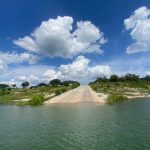A Texas Parks and Wildlife Department (TPWD) survey conducted in May links low water levels in Canyon Lake to potential problems with hydrilla, an aquatic invasive species of plant that produces long stems of up to 25 feet in length and forms dense mats of growth on the surface.
Hydrilla growth could potentially impede access to Boat Ramp #21, and TPWD’s Aquatic Habitat Enhancement Team is investigating options to prevent the plant from impeding navigation from the ramp to the main lake, Patrick Ireland, district supervisor for TPWD’s Inland Fisheries Division, said in a June 12 email to stakeholders with the U.S. Army Corps of Engineers (USACE), Guadalupe-Blanco River Authority (GBRA) and Canyon Lake property owners who last year accused TPWD of not taking the problem seriously.
TPWD will continue to closely monitor hydrilla growth in Canyon Lake and plans to conduct another vegetation survey in July to get the most accurate view of coverage at peak growing season.
In his email, Ireland said water levels have remained at least 12 feet below pool for the last four to five months, pushing hydrilla out to deeper contours but also reducing coverage in areas that are now dry.
Boat ramps #8, #23 and #7 — all closed — also have hydrilla in front of them.
Should lake levels rise TPWD would consider treating those areas, he said.
The good news is that open water in Canyon Lake is “abundant and available for recreation.” Swim beaches are generally hydrilla free. There is only 30-40% coverage of hydrilla in exposed standing timber hazards at the upper end of the lake and in coves.
In the upper end of the reservoir, the original Guadalupe River channel that skirts north and south Cranes Mill remains open and free of hydrilla.
“This should be the primary navigation channel for the upper end in the event that the hydrilla expands and tops out,” Ireland said.
Hydrilla continues to expand to about the 20-foot contour.
“However, a water level rise would certainly knock it back,” Ireland said. “It appears the 20-23 foot depth is the maximum depth for light penetration. At the far upper end (riverine section) of the reservoir, the hydrilla does not extend beyond 8-10 feet, likely due to turbidity.”
Last October, a coalition of angry Canyon Lake concerned about the impact of hydrilla in the Cranes Mill and Potters Creek areas, blasted TPWD for not doing enough about the plant, which they said created all kinds of safety issues and negatively impacted property values.
An August 2022 Canyon Lake vegetation survey showed similar coverage and distribution of hydrilla to a 2021 vegetation survey.
“At the time of the 2022 survey, Canyon Lake water level was approximately five feet below full pool level,” Ireland said in a Facebook post. . “Lower water levels have exposed greater amounts of hydrilla to the surface relative to earlier in the year and the previous two growing seasons.”
As of October 2022, the majority of hydrilla coverage was confined to the upper end of the lake and remained under the recommended coverage for aquatic vegetation for fisheries production (30% of the total surface area), he said. Hydrilla covered 10% of Canyon Lake.





Thank you Stephanie for keeping our community abreast of the massive battle we are engaged in to save the Guadalupe River / Canyon Lake from hydrilla – an invasive and non-native species.
I went out to the lake with my family last week to personally check both our water conditions and the hydrilla growth and candidly it saddened me. I launched my boat at boat ramp #18 and saw hydrilla at the ramp / dock. I drove all around the boat ramps and saw hydrilla in multiple places including boat ramp #1 (it has spread all the way down there from upriver). We were swimming next to the dam, and we saw hydrilla floating by our boat – it is everywhere.
I then proceeded to drive up the Guadalupe River towards Mystic Shores, Cordova Bend (upriver from Cranes Mill Park) and was shocked at both the timber and hydrilla. With the El Nino weather pattern hopefully coming this winter (keeping fingers crossed), I hope the lake level comes back up, but I am less optimistic with managing the hydrilla situation given how far it has spread – especially in the upper portion of Canyon Lake and the Guadalupe River.
For the record, I enjoy fishing and have heard of public comments about how great the fishing is currently. I just wish we would have been able to create an amazing fishing environment through native Texas plant life, versus the invasive and non-native hydrilla plant. When you see the banks of the Guadalupe River contaminated from the north of Cranes Mill Park extended all the way up the river for about 2-3 miles it is very disheartening and saddens me greatly. There is a large water body no longer usable for swimmers, recreational boaters, and even fishers.
We had a chance two years ago to rid the Guadalupe River of the invasive species (there was just a small area of hydrilla) and not only is it thicker, but it will eventually spread to all the banks across Canyon Lake where the depths are conducive for hydrilla growth. On top of this, all the financial gains that the State of Texas will enjoy from the enhanced fishing will be eroded from the constant treatments that will be required to contain the plant in public areas (given the expensive nature of the treatments). To be very candid, I was shocked to see the invasive plant and how much it has polluted the amazing Guadalupe River and we will never get it back to its clear water state (this hydrilla plant / legacy will long outlive us and we have forever polluted the Guadalupe River for our children and their children with this invasive species).
I have been doing a ton of research on how other states are managing hydrilla and it seems the State of Texas is taking more of a “wait and see” approach to fighting back this evasive species (as it continues to entrench itself in our water body) compared to other states. Here is just a small sample size of the how other states recognize the seriousness of hydrilla and are doing everything possible to rid this evasive species from its water bodies: Missouri (https://mdc.mo.gov/trees-plants/invasive-plants/hydrilla-control), New York (https://nyis.info/invasive_species/hydrilla/), Louisiana (https://www.lsuagcenter.com/topics/environment/invasive species/hydrilla), Pennsylvania (http://elibrary.dcnr.pa.gov/GetDocument?docId=1738725&DocName=hydrilla.pdf), Colorado (https://drive.google.com/file/d/1BnFL0M9mIgiOMXabRn1UwfRgcHbne8MV/view), Florida (https://myfwc.com/wildlifehabitats/habitat/invasive-plants/weed-alerts/hydrilla/), California (https://www.cdfa.ca.gov/plant/ipc/hydrilla/hydrilla_hp.html), Washington (https://www.nwcb.wa.gov/weeds/hydrilla), Arkansas (https://talkbusiness.net/2023/03/central-arkansas-water-begins-hydrilla-control-steps-at-lake-maumelle/), South Carolina / Georgia (https://www.nasa.gov/SpaceforUS/?story=6404). I could have probably listed every single state in the union, but it seems Texas is very low on the list in terms of concern and having a plan to fight for the once unpolluted and precious Guadalupe River / Canyon Lake.
My prediction is it is too late now as it will get worse and as the water rises (God wiling), the banks of the Guadalupe River and areas around Canyon Lake will forever be polluted with Hydrilla…a significant sacrifice for the sake of fishing in once a pristine body of water. It seems outside of significant chemical treatment, the only other option we have at this point is leveraging triploid grass carp to help us fight back this pollutant.
Dr. W. Bryant Bonner